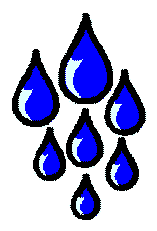OBJECTIVES: |
Students experiment with water to discover
properties.
|

|
BACKGROUND:After we finished graphing the amount of drops the penny could hold we tried the experiment on a nickel and quarter. But before we tested out the experiment I had my boys guess how many drops each would hold and record their guess in their science lab journals. Each was surprised by how many drops the quarter and nickels held but also thought it was fun to see the end results.Water remains a liquid over a very wide temperature range, namely, a range of 0°C to 100?C, between freezing and vaporization. This spans the temperatures of most parts of the Earth where life can occur.
Water has a very high specific heat, which means that it can absorb or lose much heat before its temperature changes. It takes a lot of energy to start evaporation because water has a high latent heat of vaporization. For this reason, water evaporates slowly from ponds and lakes, where many life forms are dependent on it.
Water is less dense in its solid state than in its liquid state, so that ice floats instead of sinking. This property permits life to develop in polar regions and subpolar regions where ice floats and allows life to continue living below the surface. If ice were heavier than water, it would sink, and more ice would form on top of it. As a result, all life in the waters would be trapped in the ice in the many areas of the world where it gets cold enough to freeze water.
Water's surface tension (the ability of a substance to stick to itself) makes it an excellent substance to float heavy objects upon. Water not only sticks to itself, but also to other surfaces, and this allows it to move against gravity, which is very important to plants when transporting water form the soil to their leaves. This upward motion is known as capillarity or capillary movement.
PROCEDURE: This exercise consists of two parts. First, the students will discover how water flows and secondly, the students will discover how many drops of water they can put on a penny.
In the first exercise give each child two cups. Have them measure 1 cup of water into one cup.
Let them hold both cups and ask them the following questions:
Which cup contains a fluid?
Which cup contains melted ice?
Which cup contains air?
What is the fluid?
- Next ask the students to pour the liquid. Ask them to describe the liquid. The water is flowing; it is a fluid called water.

In the second exercise give each student an eyedropper and penny. First discuss surface tension by using the following illustrations. Surface tension is what allows a water strider (insect) on water not to sink and explains why heavier items in water, float. In this exercise the students will experience surface tension by seeing how many drops of water they can put on a penny with an eyedropper. Ask students to predict how many drops can fit on a penny. You are going to have to illustrate and demonstrate very carefully how to use an eyedropper.

- Using an eyedropper, gently let water drops fall into the center of the penny. Count how many you can put on before the water runs off. (It will be between 20 and 34.) Let the children try this. Their numbers will be lower than yours, and will change depending on whether they are letting the drops fall into the center of the penny or on the edge.
- You may want to extend this lab by seeing how many drops they can place on a nickel. Go over their results. You may also want to repeat the experiment with alcohol. It has a much lower surface tension and will not be able to hold as much liquid.

- The key concept here is to have the students experience surface tension and to be able to observe surface tension when they leave the classroom.
This is really simple lab to show surface tension and can be found at msnucleus.org. Under elementary/water cycle/first grade/experiencing surface tension. Make science a fun part of homeschooling!
Jenna


















